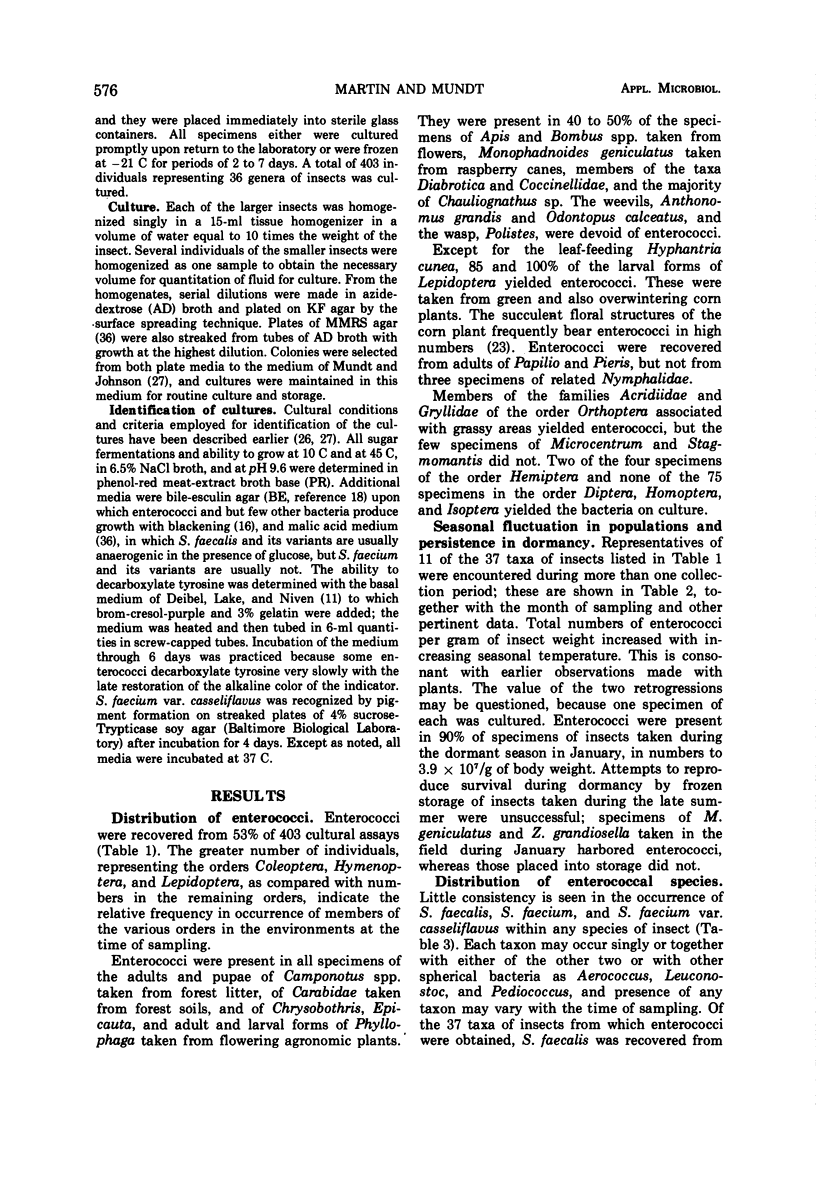Abstract
Enterococci were obtained from 213 of 403 insects cultured during a 14-month period, in numbers from 103 to 3 × 107/g of insect. Insects were taken only from nonurban, wild, and cultivated fields and woods. In species of insects carrying them, enterococci were not always present in every individual cultured, and often more than one species of enterococcus occurred within a species. Enterococci were obtained from certain insects taken in the field during the dormant season, suggesting their role as overwintering agents. They were generally present in species feeding on nectar, succulent plant parts, and on and ir forest litter, but not from insects feeding on less succulent leaves and stems. Streptococcus faecalis was recovered from 32%, Streptococcus faecium from 22.4%, and Streptococcus faecium var. casseliflavus from 43.5% of members of the 37 taxa of insects. S. faecalis and S. faecium var. casseliflavus exhibit a high percent of conformity to the properties published for them. The heterogeneity in properties of S. faecium is similar to that found for the species taken from plants. Many fail to grow in broth at 45 C or in broth containing 6.5% NaCl; 50% of the cultures ferment both melezitose and melibiose, and a few ferment neither sugar. The remainder ferment melibiose only. Failure to reduce methylene blue in milk by S. faecalis and S. faecium is correlated with the inability to ferment lactose. More than 93% of the cultures of S. faecalis digest casein in milk from the top downward, following the production of a soft, flowing curd. Because this property is not characteristic of S. faecalis taken from humans, the reaction in litmus milk is suggested as a means of differentiation between cultures of remote and innocent origin in nature and recent, human pollution.
Full text
PDF





Selected References
These references are in PubMed. This may not be the complete list of references from this article.
- BARNES E. M. Tetrazolium reduction as a means of differentiating Streptococcus faecalis from Streptococcus faecium. J Gen Microbiol. 1956 Feb;14(1):57–68. doi: 10.1099/00221287-14-1-57. [DOI] [PubMed] [Google Scholar]
- BARTLEY C. H., SLANETZ L. W. Types and sanitary significance of fecal Streptococci isolated from feces, sewage, and water. Am J Public Health Nations Health. 1960 Oct;50:1545–1552. doi: 10.2105/ajph.50.10.1545. [DOI] [PMC free article] [PubMed] [Google Scholar]
- Bucher G. E., Bracken G. K. Fungus disease of adult parasitic insects caused by Torula nigra (Marpmann). J Invertebr Pathol. 1966 Jun;8(2):193–204. doi: 10.1016/0022-2011(66)90129-7. [DOI] [PubMed] [Google Scholar]
- DEIBEL R. H., LAKE D. E., NIVEN C. F., Jr PHYSIOLOGY OF THE ENTEROCOCCI AS RELATED TO THEIR TAXONOMY. J Bacteriol. 1963 Dec;86:1275–1282. doi: 10.1128/jb.86.6.1275-1282.1963. [DOI] [PMC free article] [PubMed] [Google Scholar]
- DEIBEL R. H. THE GROUP D STREPTOCOCCI. Bacteriol Rev. 1964 Sep;28:330–366. doi: 10.1128/br.28.3.330-366.1964. [DOI] [PMC free article] [PubMed] [Google Scholar]
- Facklam R. R., Moody M. D. Presumptive identification of group D streptococci: the bile-esculin test. Appl Microbiol. 1970 Aug;20(2):245–250. doi: 10.1128/am.20.2.245-250.1970. [DOI] [PMC free article] [PubMed] [Google Scholar]
- GELDREICH E. E., KENNER B. A., KABLER P. W. OCCURRENCE OF COLIFORMS, FECAL COLIFORMS, AND STREPTOCOCCI ON VEGETATION AND INSECTS. Appl Microbiol. 1964 Jan;12:63–69. doi: 10.1128/am.12.1.63-69.1964. [DOI] [PMC free article] [PubMed] [Google Scholar]
- Isenberg H. D., Goldberg D., Sampson J. Laboratory studies with a selective Enterococcus medium. Appl Microbiol. 1970 Sep;20(3):433–436. doi: 10.1128/am.20.3.433-436.1970. [DOI] [PMC free article] [PubMed] [Google Scholar]
- MUNDT J. O. Occurrence of enterococci in animals in a wild environment. Appl Microbiol. 1963 Mar;11:136–140. doi: 10.1128/am.11.2.136-140.1963. [DOI] [PMC free article] [PubMed] [Google Scholar]
- MUNDT J. O. Occurrence of enterococci on plants in a wild environment. Appl Microbiol. 1963 Mar;11:141–144. doi: 10.1128/am.11.2.141-144.1963. [DOI] [PMC free article] [PubMed] [Google Scholar]
- Mundt J. O., Graham W. F., McCarty I. E. Spherical Lactic Acid-producing Bacteria of Southern-grown Raw and Processed Vegetables. Appl Microbiol. 1967 Nov;15(6):1303–1308. doi: 10.1128/am.15.6.1303-1308.1967. [DOI] [PMC free article] [PubMed] [Google Scholar]
- Mundt J. O. Occurrence of Enterococci: Bud, Blossom, and Soil Studies. Appl Microbiol. 1961 Nov;9(6):541–544. doi: 10.1128/am.9.6.541-544.1961. [DOI] [PMC free article] [PubMed] [Google Scholar]
- POST F. J., FOSTER F. J., Jr DISTRIBUTION AND CHARACTERIZATION OF FECAL STREPTOCOCCI IN MUSCOID FLIES. J Invertebr Pathol. 1965 Mar;20:22–28. doi: 10.1016/0022-2011(65)90147-3. [DOI] [PubMed] [Google Scholar]
- Sherman J. M., Mauer J. C., Stark P. Streptococcus fecalis. J Bacteriol. 1937 Mar;33(3):275–282. doi: 10.1128/jb.33.3.275-282.1937. [DOI] [PMC free article] [PubMed] [Google Scholar]
- Stevenson J. P. Motile streptococci from the desert locust, Schistocerca gregaria. J Invertebr Pathol. 1966 Jun;8(2):258–259. doi: 10.1016/0022-2011(66)90140-6. [DOI] [PubMed] [Google Scholar]
- WHITTENBURY R. THE DIFFERENTIATION OF STREPTOCOCCUS FAECALIS AND S. FAECIUM. J Gen Microbiol. 1965 Feb;38:279–287. doi: 10.1099/00221287-38-2-279. [DOI] [PubMed] [Google Scholar]


